B0041VYHGW EBOK (88 page)
Authors: David Bordwell,Kristin Thompson

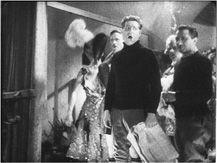
5.186 … and farther right as others onstage sing along.
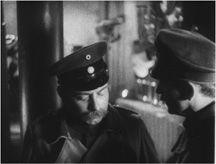
5.187 A tilt down shows two worried German guards …
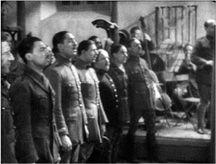
5.188 … and a track back to the left reveals a row of French prisoners in the audience on their feet, singing.
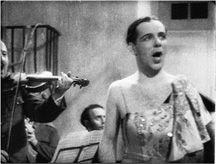
5.189 The camera tracks forward past them to the musicians and singer again …
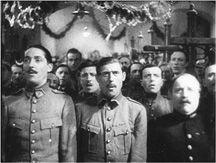
5.190 … then pans quickly left to face the entire audience.
In Elsa’s cottage as well as in the prison, camera movement links characters. After feeding a cow, Maréchal enters the house, and a pan with him reveals Elsa scrubbing the floor. The culmination of the linking movement comes near the film’s end, when Renoir pans from the Germans on one side of the border
(
5.191
)
to the distant French escapees on the other
(
5.192
,
5.193
).
Even on this scale, Renoir’s camera refuses to honor national divisions.
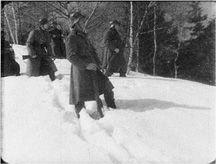
5.191 As the Germans realize that Maréchal and Rosenthal have crossed over into Switzerland …
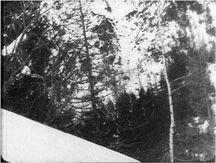
5.192 … Renoir pans to the right across the invisible border …
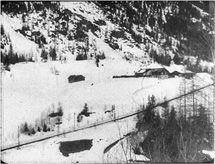
5.193 … to the two escapees, tiny dots in the huge landscape.
The French film critic André Bazin remarked: “Jean Renoir found a way to reveal the hidden meaning of people and things without destroying the unity that is natural to them.” By placing emphasis and making comparisons, the mobile frame in
Grand Illusion
becomes as important as the mise-en-scene. The camera movements carve into space to create connections that enrich the film’s narrative form.
In Michael Snow’s experimental film
Wavelength,
the relation of narrative to the mobile frame is quite different. Instead of supporting narrative form, frame mobility dominates narrative, even deflecting our attention from events. The film begins with a long-shot framing of a loft apartment, facing one wall and window
(
5.194
).
In the course of the film, the camera zooms in abruptly a short distance and then holds that framing. It zooms in a bit more and then holds that
(
5.195
).
And so it goes throughout the film’s 45-minute length. By the end, a photograph of ocean waves on the distant wall fills the frame in close-up.
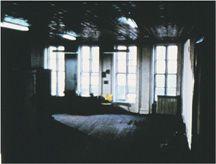
5.194 Early in
Wavelength,
much of the apartment is visible.
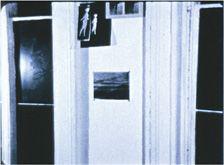
5.195 Near the end, the sporadic zoom-ins have made details of the far wall visible.
Thus
Wavelength
is structured primarily around a single kind of frame mobility—the zoom-in. Its pattern of progression and development is not a narrative one, but one of exploration, through deliberately limited means, of how the zoom transforms the space of the loft. The sudden zooms create frequent abrupt shifts of perspective relations. In excluding parts of the room, the zoom-in also magnifies and flattens what we see; every change of focal length gives us a new set of spatial relations. The zoom places more and more space offscreen. The sound track, for the most part, reinforces the basic formal progression by emitting a single humming tone that rises consistently in pitch as the zoom magnifies the space more and more.
Within
Wavelength
’s basic pattern, though, there are two contrasting systems. The first is a series of filtered tints that plays across the image as abstract fields of color. These tints often work against the depth represented in the shot of the loft.
A second system evokes a sketchy narrative. At various intervals, characters enter the loft and carry on certain activities (talking, listening to the radio, making phone calls). There is even a mysterious death (a body lies on the floor in
5.196
).
But these events remain unexplained in cause–effect terms and inconclusive as to closure (although at the film’s end we do hear a sound that resembles a police siren). Furthermore, none of these actions swerves the mobile framing from its predetermined course. The jerkily shifting and halting zoom continues, even when it excludes important narrative information. Thus
Wavelength
pulls in bits and pieces of narrative, but these fragments of action remain secondary, operating within the temporal progression of the zoom.
